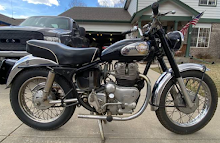 |
| The Wright Flyer on display in London in 1928. (Photo from Wright-Brothers.org) |
The Royal Enfield factory was underground, in Westwood, Wiltshire, as Jorge Pullin has documented in his articles on the once secret Westwood factory.
During the war Royal Enfield workers under ground produced precision equipment for the military; after the war Royal Enfield motorcycle production continued there, including, at the end, the Royal Enfield Interceptor.
The Wright Brothers' Flyer was underground during the war, too, for safe keeping. But as Jorge pointed out in a comment on my item, that bunker was 10 miles away from Royal Enfield, under the community of Corsham. I'd carelessly assumed that Wiltshire would have had only one great underground factory complex.
Hardly. The region, extensively quarried, held a warren of underground passages. The list of eventual military sites under Corsham alone is extensive.
Underground quarries were investigated for military use at least as early as World War I, when it suddenly became necessary to find places to put ammunition that would be safe from aerial bombing. In the run-up to World War II Britain's tunnels and galleries got a fresh look.
The Blitz prompted elaborate plans to put whole factories underground and, as in the case of Royal Enfield, this was done. The enormous expense involved in modifying and air conditioning the damp passageways eventually foiled some other schemes.
The onset of the Cold War and fear of nuclear weapons brought underground projects back to life. Immense command and control centers and hideaways for the government were created, all documented in the BBC documentary "Wiltshire's Underground City."
This dealt with the 35-acre secret underground city 100 feet beneath Corsham. You get some idea of the extent of the Secret City from this BBC map of the complex.
Obviously, details of these sites could not be kept secret — the quarries themselves had never been secrets — and the growing accuracy of nuclear weapons meant that even 100 feet below ground was no longer safe.
(Britain's modern plans for emergencies supposedly call for government to be dispersed to places of safety rather than concentrated in one underground bulls eye.)
As for the Wright Flyer, Elizabeth C. Borja, reference services archivist for the Smithsonian Institution, was kind enough to send me a chronology of the airplane's time in Britain, including its days under ground.
Although unrelated to Royal Enfield, this chronology is fascinating to anyone interested in wartime Britain.
Sent to the Science Museum in London by Orville Wright, the plane went on exhibit there in 1928. Surprising to me, it first went underground in September, 1938 — although this time just into the basement of the museum — for safe keeping during the crisis over the Sudetenland.
It begins to dawn on me that Britains really did fear the outbreak of war in 1938 and the bombing it would bring.
With short-lived "Peace In Our Time" decreed at Munich, the Flyer went back on display. When war then did come in 1939 it was at first left on display, but surrounded by reinforced screens to protect it from bomb blast.
It was soon back in the museum's basement. But even this wasn't considered safe enough. On April 8, 1942 the Wright Flyer was stored 100 feet under Corsham in a quarry used by the Royal Army Ordinance Corps.
On February 17, 1943, it moved to a better air conditioned Admiralty quarry 70 feet underground at Corsham. There it stayed until, war over, returning to the London museum on June 7, 1945.
Inspection showed it had suffered only a little rust under ground. But it wouldn't stay in London long.
It would move to the Smithsonian Institution in Washington, D.C. in 1948, where it remains.






















No comments:
Post a Comment